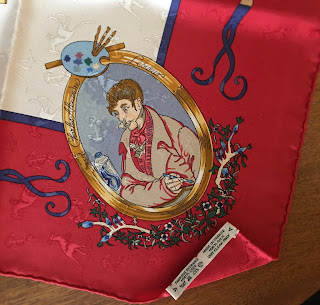Another question is why Le Géographe - a masculine article ???
I thought Géographie is feminine. (and it is)
Turns out, Le Géographe means geographer.
So the ship is named "The Geographer".
Le Géographe was originally a 20-gun ship (Serpente-class corvette) of the French Navy.
On 19 October 1800, under captain Nicolas Baudin, she left Le Havre with another ship, the Naturaliste for an exploration of Australia.
This provides a rear view of the ship.
There were 22 scientists, scholars, painters, and designers, and gardeners, on the voyage, including three who, along with Baudin, are shown in the corners of the scarf.
Here is Nicholas Baudin, Captain of the ship, "Le Géographe"
François Péron
Péron was a naturalist who helped gather 100000 specimens of 2500 species.
He also wrote the first volume of Voyage de Découvertes aux Terres Australes … sur les Corvettes le Géographe, le Naturaliste et la Goélette le Casuarina, pendant les Années 1800, 1801, 1802, 1803 et 1804 (Paris, 1807-16). http://adb.anu.edu.au/biography/peron-francois-2545 He only got as far as page 230 of volume two when his health declined and he was unable to continue.
Flinders was a navigator and cartographer who led the second circumnavigation of New Holland. He also confirmed that Tasmania was an island. Britain and France were at war at that time, and as he tried to repair his ship in Isle de France (Mauritania), the governor declined to allow safe passage and imprisoned him for 6 years. That gave him time to write up his discoveries, including his proposal to name the continent Australia.
~~ ~ ~~
The scarf is a jacquard silk with kangaroos and anchors woven into the texture of the scarf. Because the technique of making the fabric is expensive, the jacquard scarves are rarely faked.
So this is not the beginning of a geography series. The scarf is named after the ship, not the subject. The themes are Australia and exploration so that explains the kangaroos and anchors. It's a stunning Hermès scarf.
~~ ~ ~~
"I can see the sextant paired with the captain and the compass for the navigator and the palette for the artist, but I don't get the semi-circle (can't think of the actual name of the thing, (It's a compass, too.) but it's used to measuring angles in geometry) and the sort of triangular thing (it also has a name that is escaping me) I think it's a "sector:" https://en.wikipedia.org/wiki/Sector_(instrument) for the naturalist. I wonder if he was a Mason?"
I don't know if Péron was a Mason, but he did study medicine (hence the caduceus). I think those tools are used for measuring and mapmaking. He was a serious researcher, for example taking temperature measurements of the ocean at various depths every six hours.
"It was also interesting that under each medallion were different symbols: sword and scabbard for the captain (did he have a military commission?); Flinders also had sword and scabbard and was wearing a military uniform. While the swords and scabbards are the same, the "vegetation" below the other two portraits are different. One looks like blueberries to me, but I don't recognize the other one - laurel, perhaps?"
I think they all were in the army or navy.
D pointed out (per Wikipedia):
"The name Australia derives from Latin australis meaning southern, and dates back to 2nd century legends of an "unknown southern land" (that is terra australis incognita). The explorer Matthew Flinders named the land Terra Australis, which was later abbreviated to the current form."
It's definitely an interesting scarf!







1 comment:
OK. I can see the sextant paired with the captain and the compass for the navigator and the palette for the artist, but I don't get the semi-circle (can't think of the actual name of the thing, but it's used to measuring angles in geometry) and the sort of triangular thing (it also has a name that is escaping me) for the naturalist. I wonder if he was a Mason?
It was also interesting that under each medallion were different symbols: sword and scabbard for the captain (did he have a military commission?); Flinders also had sword and scabbard and was wearing a military uniform. While the swords and scabbards are the same, the "vegetation" below the other two portraits are different. One looks like blueberries to me, but I don't recognize the other one - laurel, perhaps?
And what is the thing below Peron with the snake wrapping around it?
Fascinating! You might want to look up other expeditions to see if Hermes documented and celebrated them. Have fun! (Obviously, you are!)
Post a Comment